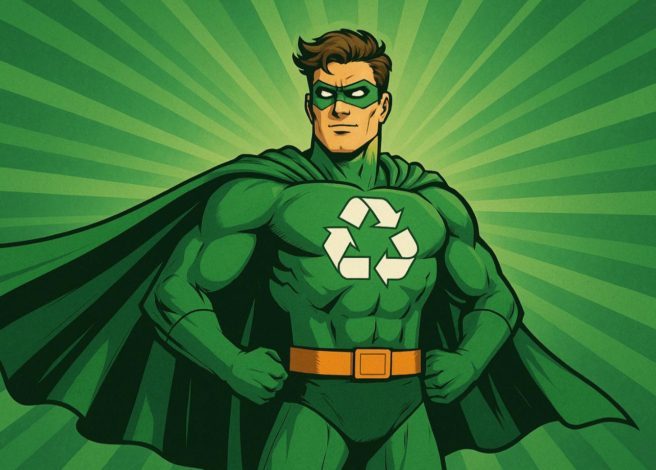At a Glance
- Master recycling codes: Recycle food-grade plastics (#1, #2, #5); avoid polystyrene and mixed plastics.
- Prep simply but smart: Light rinse only; leave caps, labels, and rings on.
- Optimize for equipment: Compress containers; keep small items attached so they don’t get thrown out.
- Know your local MRF: Understand nearby recycling tech and systems to design packaging that actually gets recycled.
You’re a food industry pro.
There isn’t a challenge you haven’t stood up to (or at least, not yet. There is still time for the Food Network to ask to shoot a new show about the hottest new snack trends at your business). You’re already solving complex daily issues — from supply chain logistics to food safety compliance. One area where even top operations struggle is in finding recycling practices that yield real results.
You know sustainability matters to your customers and your bottom line. You’ve seen competitors win contracts partly based on their environmental credentials. Yet navigating the maze of recycling requirements feels like trying to follow a recipe with only half the ingredients (another new Food Network show proposition).
Trusted Guidance
Industry leaders know this: Mastering recycling is more than being eco-friendly. It cuts costs, boosts your brand’s reputation, and makes your business stand out in a crowded market.
Madelyn Hart, USA Waste & Recycling’s Outreach Specialist, has promoted environmental education with municipalities, schools, and businesses since 2023. She creates programs and builds community partnerships. Madelyn holds a Master’s in Public Administration from UCONN and is on a mission to help people understand waste management.
We worked with her to produce this guide to show you exactly what to recycle, how to prepare it properly, and how to educate your customers in ways that build brand loyalty.
You can use these simple methods to lower costs, prevent contamination, and boost your status as an industry leader.
The Challenge Every Food Professional Faces

Image created using AI.
Today, consumers and business partners want food companies to show real care for the environment. Yet many professionals struggle with the same frustrating problems:
- Confusion about what’s actually recyclable leads to contaminated streams and rejected loads.
- Inconsistent practices across your facility create inefficiencies and missed opportunities.
- Lack of clear protocols results in staff confusion and potential liability issues.
- Rising waste disposal costs eat into already tight profit margins.
Sound familiar? You’re not alone. Even top food industry experts hit recycling roadblocks. These issues can hurt their profits and brand image.
When recycling practices aren’t optimized, the consequences extend far beyond environmental impact. When your facility’s recycling gets rejected because of contamination, it creates problems. You end up paying high rates for waste disposal. Plus, you risk losing trust with partners who care about sustainability.
Here are three steps you need to take before we dive any further:
- Don’t give up on recycling because of confusion and frustration.
- Open your mind to change.
- Worry not. We’ve got your back.
Your Path to Recycling Mastery
The good news? Implementing effective recycling practices is more straightforward than most food industry professionals realize. Here’s your roadmap to recycling success:
Master the Fundamentals

Image created using AI.
Start with food-grade packaging identification. Most food-grade packaging can be recycled. But Styrofoam, polystyrene mixes, and “number seven mixed plastics” don’t count. These refer to the “material codes” or “resin identification codes.” You can find them on plastic items as a triangle of arrows with a number inside. This simple rule applies to most containers your facility sees every day. It includes juice containers and food packaging.
Simplify Your Container Preparation
Here’s where many professionals overthink the process. Many modern recycling facilities are designed to handle attached components, so you don’t need to:
- Remove labels from containers
- Separate caps from bottles
- Remove the small plastic rings that attach caps
You can just rinse containers lightly to get rid of food residue. There is no need for dishwasher-level cleaning. The key is preventing food waste that attracts pests and degrades other recyclable materials in the stream.
It’s important to note that not all MRFs (Material Recovery Facilities — where items to be recycled are sorted) are on the modern or high-end scale as every MRF is different. Each MRF has unique processing capabilities.
Optimize Your Materials for Processing
Compress air-filled containers like water bottles and milk jugs when placing them in a recycling bin. This maximizes your recycling bin capacity and prevents caps from popping off during truck compaction. For aluminum cans, keep the tabs on. Manufacturers expect this, and it adds extra value by weight.
Keep small items attached to larger ones. Items under two inches in diameter typically get processed as residue waste. For example, keep bottle caps on the bottles when recycling. This helps ensure they are processed correctly.
Handle Mixed-Material Items Strategically
Those oat milk cartons with plastic caps? Leave them assembled. Many modern sorting centers, like USA Waste & Recycling, are equipped to handle this combination of materials. (Check it out here!). End users who receive this material have their own final cleaning processes to prepare materials for reuse. The same principle applies to glass containers with metal lids — leave lids attached so they don’t get lost during their journey to the recycling facility.
Avoid Critical Contamination Mistakes
Never place recyclables in garbage bags, even if you try to keep them organized. Plastic bags can become entangled in machinery and create safety hazards for workers.
Watch out for “tanglers”— items like plastic bags, wire, or chains that can jam sorting equipment and shut down entire processing lines. These materials require special handling. Many grocery stores offer takeback programs as an alternative way to recycle plastic bags and films.
The Competitive Advantage of Excellence

Image created using AI.
By consistently using these best practices, you enhance waste management and gain a competitive edge:
- Cost reduction: Recycling cuts waste disposal fees. In some cases, it can also earn money through commodity sales.
- Brand enhancement: Demonstrating genuine environmental stewardship attracts sustainability-conscious customers and partners.
- Operational efficiency: Clear, simple protocols reduce staff confusion and improve facility cleanliness.
- Regulatory compliance: Proper waste stream management supports environmental compliance and reduces audit risks.
- Future-proofing: As regulations tighten and sustainability expectations increase, early adopters maintain competitive positioning.
Your Implementation Strategy
Begin by reviewing your current practices. Find the top containers your business uses the most. Implement best practices for these materials first, then expand your program gradually.

Image created using AI.
Train your team on the simpler prep methods. Stress that less manual separation usually leads to better results. Create visual guides showing proper preparation techniques for your most common recyclable materials.
Think about teaming up with recycling facilities that use single-stream processing. This makes collection easier and keeps material quality high with better-sorting technologies.
Extend Your Impact Through Customer Education
Food industry pros can stand out by teaching customers how to recycle product packaging properly. This creates a strong ripple effect, boosting your brand and helping you recycle more successfully.
Make your packaging an education tool: Put easy recycling instructions on your product packaging. “Rinse lightly, keep the cap or lid on, and recycle with confidence.” This can help position your brand as environmentally responsible and customer-focused. You can also choose to purchase packaging that already has instructions such as “PLEASE RECYCLE ME” embossed on it.
Create educational content: Provide simple materials that help customers avoid over-cleaning containers. They also don’t need to separate each component. Many consumers waste time removing labels and separating caps. Simple rinsing is enough. By teaching these efficiencies, you help them recycle better, which also builds brand loyalty.
Address common customer misconceptions: Some people think they need to remove all labels. They believe they must sort every piece or clean as if they were in a restaurant. Modern recycling facilities are built to manage these attachments. So, “good enough” preparation can lead to better results than over-processing. (We know, in your business, you never settle for “good enough,” especially with your food. But in this instance, it’s okay!)

Image created using AI.
Partner with local waste management. Connect with recycling facilities to learn their requirements. Then, share this info with your customers. What you can recycle depends on where you are. Being a knowledgeable resource helps you gain trust and authority in your market.
This customer education approach turns your packaging into a tool for sustainability. It sets your brand apart and helps boost recycling rates among your customers.
Keep Calm and Recycle On
Here’s the beautiful irony: your competitors are still trying to figure out which bin the yogurt container goes in (spoiler: it’s recyclable) while you’ll be setting the standard for sustainability and building real operational advantages.

Image created using AI.
Successful companies will see recycling as a key business strategy in the future. It’s not just a box to check for compliance. Your commitment to best practices today gives you an edge tomorrow. Plus, it feels great to turn a headache into a profit center.
Ready to transform your recycling program from a necessary expense into a strategic asset? Begin with these basics. Track your progress. See how your improved practices boost your profits and reputation. Nothing says “industry leader” quite like being the operation that actually knows what to do with a milk jug.
Are you interested in learning more about USA Waste & Recycling? Visit their website today or contact them directly!
Want to learn more about packaging sustainability? Visit the Inline Plastics Learning Center today!

